|
Monday, May 16, 2011
Progress Notes
The economic downturn the nation has experienced over the last two years inevitably has brought up the subject of the nation’s banks and banking in general. It is interesting to me that in Miller County banks were not an early part of its growth and development. The County had two banks in 1899, both north of the Osage River. The Exchange Bank in Olean organized in 1889 and Bank of Eldon in 1894. The Bank of Iberia became the county's third bank in 1899 followed by the Bank of Tuscumbia in 1902, Citizens Bank of Eldon in 1905, Bank of Brumley in 1906, Farmers & Traders Bank of Iberia in 1907 and Bank of St. Elizabeth in 1914. Our website has discussed the history of several of these banks at this page on our website.
I previously discussed the Citizen’s Bank of Eldon at this previous Progress Notes.
This week I will discuss the early history of the Bank of Tuscumbia. The bank is interesting because although Tuscumbia’s population has not grown over the years, this bank continues to thrive. The original building located in the old part of the town is still standing although in disrepair. Here is an aerial photo of Tuscumbia in which the bank is located in the left center across the narrow road from the Presbyterian Church (photo 01).
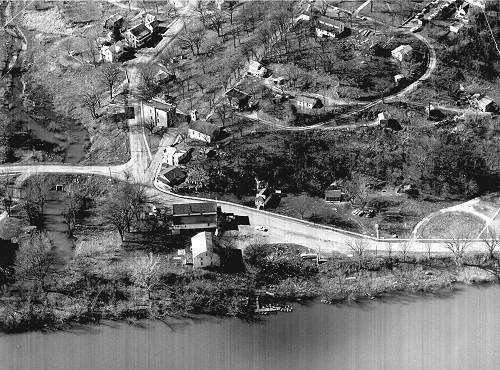
01 Aerial view of Tuscumbia - 1950's
Another closer photo of the bank was taken from a vantage slightly up the hill (photo 02).
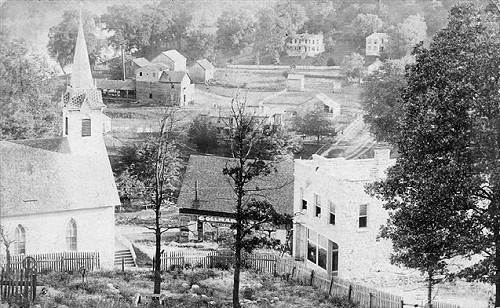
02 Looking toward Goosebottom from above Presbyterian Church and Bank
A third photo of the bank taken in the late 1940’s is from below looking up the hill (photo 03).
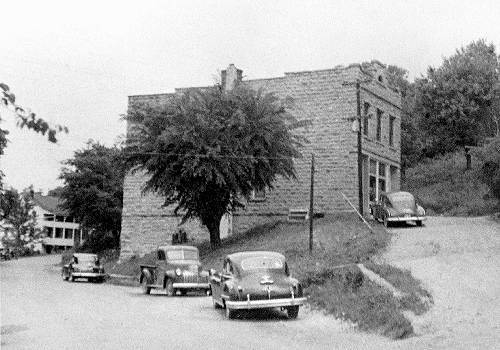
03 From below the Bank in the late 1940's
The earliest history of the bank can be found in a series of short notes taken from the Miller County Autogram in 1902:
January 23, 1902
Captain Marshall is having trouble to keep the money bags of Tuscumbia from taking all the bank stock. It would be no trouble at all to incorporate a bank at this place with a capital of $25,000. The people of this place do not know how much money they have until they shake down their trousers a couple of times.
December 18, 1902
At last Tuscumbia has a bank fully reorganized and ready for business as soon as the incorporation papers return from the Secretary of State.
The stockholders of the Bank met in their splendid stone structure Tuesday afternoon and organized by electing Captain R.M. Marshall, Honorable H.C. Jackson, J.R. Wells, W.M. Harrison, and George T. Haunstein a board of directors for the ensuing year. At an executive session of the board, Captain R.M. Marshall was elected president; Honorable H.C. Jackson, vice president; W.M. Harrison, secretary; and George T. Hauenstein, treasurer.
The capital stock was increased to $15,000, the additional $5,000 being taken in a few minutes.
The safe, counters, etc., will be here in a few days, and it is expected that the new bank will open its doors with the beginning of the New Year.
January 8, 1903
The bank safe arrived last week, and counters, etc., arrived Tuesday, and President Marshall thinks the bank will open its doors for business next Monday. The safe is of the newest pattern and is safeguarded with all the newest devices against robbery that the skill of man has been able to make at this time. It was made by the Victor Company and is known as the screw door safe. It will hardly average 39 inches square, yet its weight is 2,700 pounds.
January 15, 1903
The Bank of Tuscumbia opened its doors for business Monday morning, the deposits amounting to several thousand dollars during the day. Cashier William Hauenstein is being assisted by Circuit Clerk Harrison until the former gets the run of the business. The bank will be of untold benefit to the town and surrounding country and in a short time we will all be wondering how it was possible to have gotten along without it.
Here are short biographies of some of the early officers of the bank mentioned above:
Captain Robert Melville Marshall (photo 04) was a former riverboat captain on the Osage and in 1903 was president of the Bank of Tuscumbia.
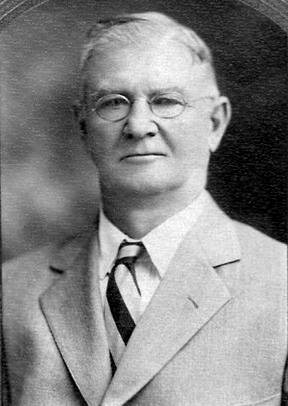
04 Captain Robert Marshall
He and his wife, Emma (Hauenstein), lived in their beautiful home near the banks of the Osage, located today west of Riverside Park. His biography is told at this previous Progress Notes.
Joshua R. Wells (photo 05) was a prosperous farmer as well as one of the officers of the Anchor Mill.
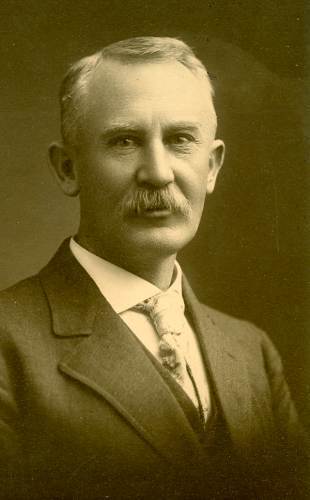
05 Joshua R. Wells
His majestic home was built about a mile downriver from Tuscumbia and still exists today, although moved a few hundred yards up the hill from the original location in the early 1940’s (due to flooding of the Osage over the years). Joshua, his wife, Lucy (Lawson) and their five children were living on the Wells farm in 1900. His biography can be read at this previous Progress Notes.
George T. Hauenstein (photo 06) was a general store merchant in Tuscumbia at the turn of the century.
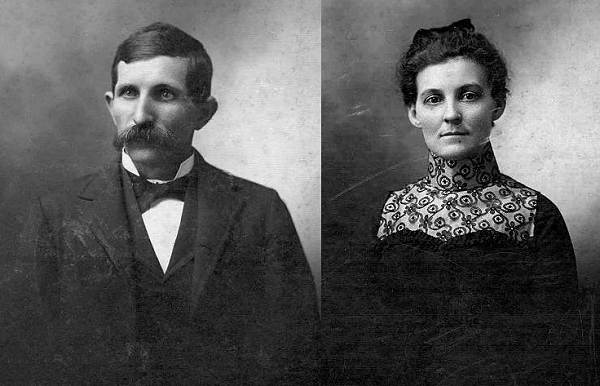
06 George and Ida Hauenstein
George (who was a nephew of William Hauenstein Sr.) and his wife, Ida, lived in Tuscumbia during the census taken in 1900. His life in Tuscumbia is the subject of this previous Progress Notes.
William H. Hauenstein Jr. (photo 07) was part owner of the Miller County Abstract Company and was cashier of the Bank of Tuscumbia.
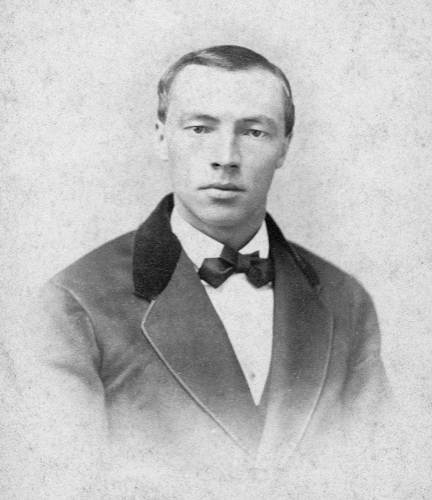
07 William Hauenstein Jr.
In 1900, William was living in Tuscumbia with his wife, Martha (Challes) and their three children. You can read more about him at this previous Progress Notes.
William M. Harrison (photo 08) originally was from Eldon but lived in Tuscumbia during the time of the establishment of the bank while he was Circuit Clerk at the Court House.
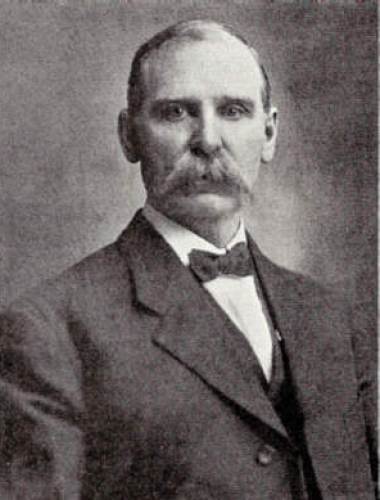
08 Wiliam M. Harrison
Later, he was an officer of the Bank of Eldon for a short time and after that established the Citizen’s Bank of Eldon. You can read more about him at this previous Progess Notes.
Here is a photo of the original bank safe, now located inside the second and present location of the bank on top of the hill (photo 09):
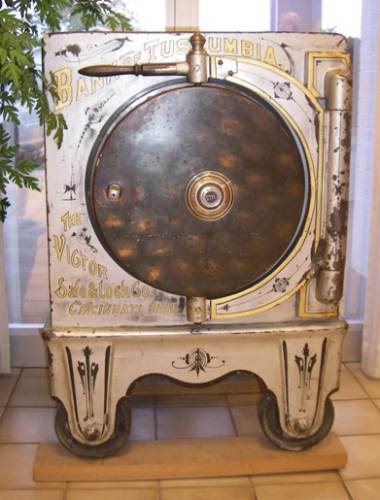
09 Original Safe
The Bank of Tuscumbia prospered early on during those first years. One of the first cashiers after the bank was organized was Fred Fendorf (father of Helen Fendorf Phillips of Eldon who recently passed away). Here is a photo of Fred taken early in his life (photo 10):
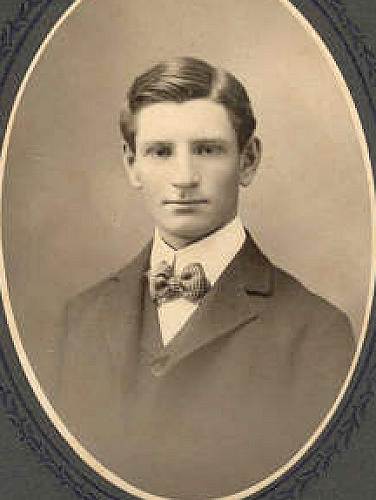
10 Fred Fendorf
And here is a photo of Fred and Captain Bob Marshall in the new bank (photo 11):
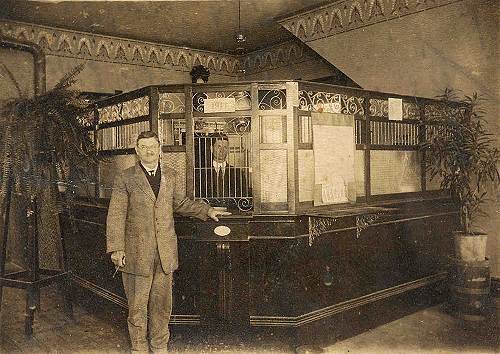
11 Robert Marshall and Fred Fendorf
Unfortunately, Fred suffered an early death passing away in 1917. You can read more about him as well as his daughter Helen Fendorf Phillips at this previous Progress Notes.
After Fred Fendorf, Byron Hix was cashier for a short time then he had to serve in WWI. While he was gone a number of cashiers were employed by the bank until Byron returned from the war in 1919 at which time he once again assumed the position of cashier (photo 12).
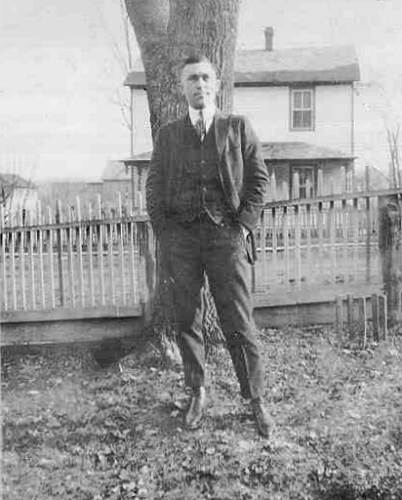
12 Byron Hix
Byron began working for the bank in 1916 but soon had to leave to join American forces fighting in Europe during WWI. He rejoined the Bank after the war ended in 1918. After fifty two years of employment at the bank, he retired in 1968. He remarked at his retirement ceremony that when he first began, posting was all done by hand, not electronically. Bank resources had grown in those fifty some odd years from $150, 000 to $3,000,000 at the time of his retirement. Bryon’s adult life was lived in a home he built on High Street in Tuscumbia (photo 13).
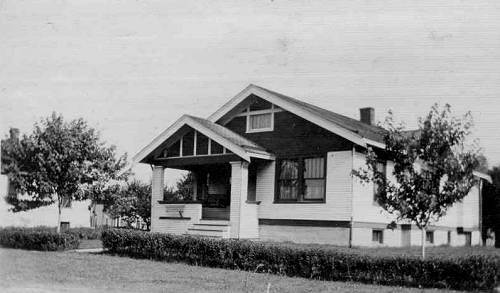
13 Byron Hix Home on High Street
He often would walk down the 117 steps from High Street to reach the Bank each day (photo 14).
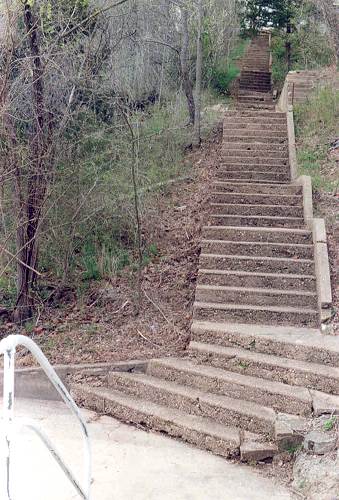
14 Courthouse Hill Steps
Byron’s home recently was purchased from Janet Hix Buthold, daughter of Byron, by Carl McDonald who is remodeling it with the help of Jim Clark. Carl plans to move to the home soon. You can read more about Byron and his family at this previous Progress Notes.
The second story of the bank most of the time was rented by two physicians; first Dr. Douglas Kouns and second by Dr. Marshall Humphreys (photos 15 and 16).
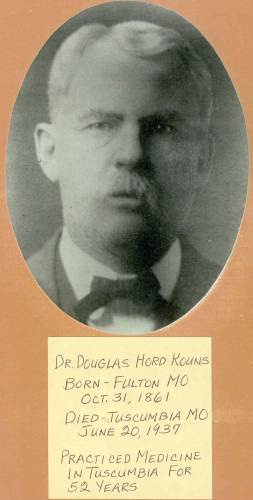
15 Dr. Douglas Hord Kouns
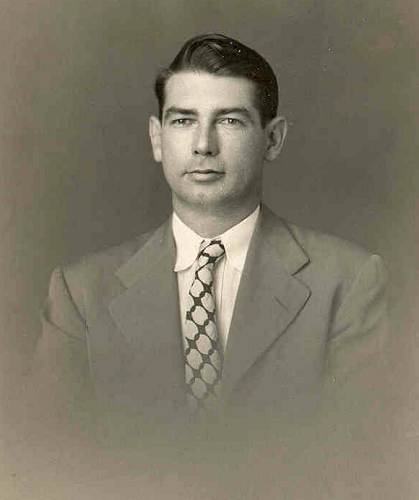
16 Dr. Marshall Humphreys
Here is a photo of the bank when Dr. Kouns rented the upper level (photo 17):
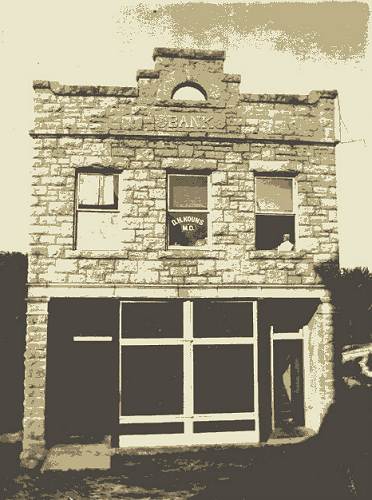
17 Tuscumbia Bank - Upper level rented to Dr. Kouns
I wonder if the man in the photo is Dr. Kouns? Although usually home births were most common, occasionally deliveries were performed by these physicians in the upper level of the bank.
One interesting story associated with the Bank of Tuscumbia was an old lemon tree, more than one hundred years old, which has been kept alive for many years even up to now. The tree was owned by Clyde and Lucy Hawken who gave it to the bank for caretaking one year while they went to Alaska sometime in the 1950’s. The tree was well cared during that time and returned to Clyde and Lucy on their return (photo 18).

18 Lemon Tree Still Living
You can read more about the lemon tree story at this previous Progress Notes.
The tree, which originally was owned by Clyde’s grandfather, George Edwards, is still alive and now in the possession of Miller County Historical Society board member, Karen Wyrick Smith, who is a great granddaughter of George Edwards. I emailed Karen the other day to inquire about the tree, which must be about 100 years old. Here is what she wrote in response:
“Yes...the lemon tree is at my house and on its death bed. Not sure I can save it.”
So, that is the latest not so happy news about the old lemon tree which was entrusted to the care of the Bank of Tuscumbia years ago.
When the bank was located below the hill the board regularly sent its customers a calendar which featured pretty photographs and multiple tables and charts of interest to farmers. Here are some photos of the 1947 edition (photos 19 - 23):
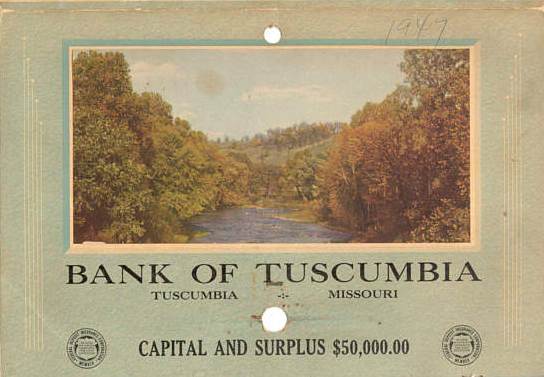
19 Bank Calendar - 1947
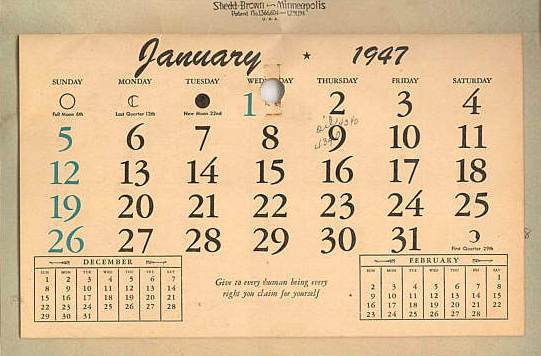
20 Bank Calendar - 1947
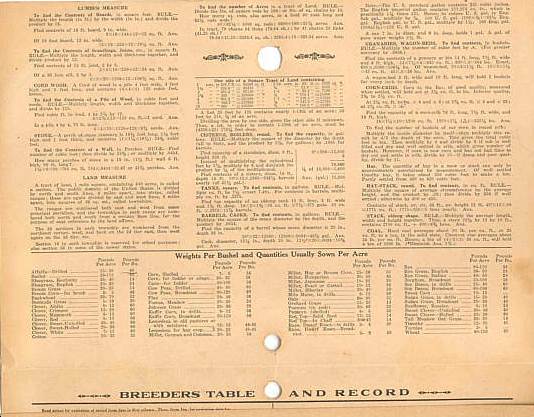
21 Bank Calendar - 1947
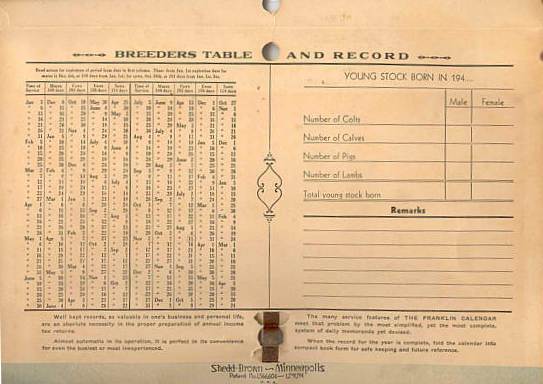
22 Bank Calendar - 1947
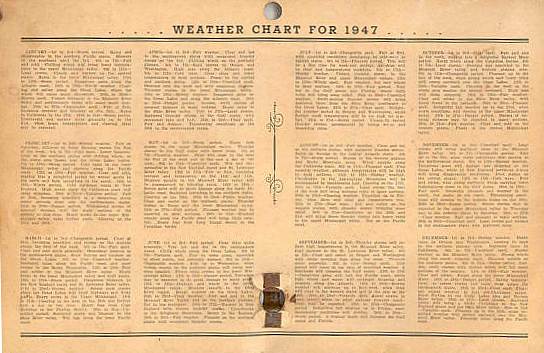
23 Bank Calendar - 1947
Also, the bank gave away post cards for notes to be sent through the postal office (photo 24).
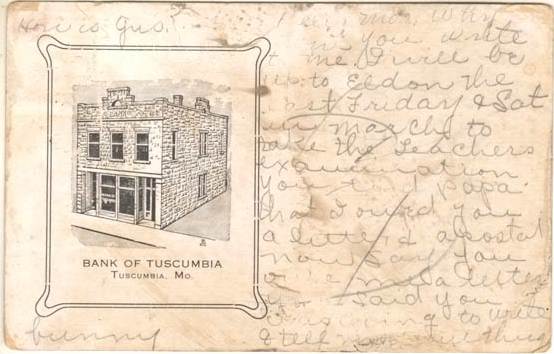
24 Bank of Tuscumbia Post Card
The bank was robbed once in 1954, the first time in its history. This interesting and exciting story is well told at this previous Progress Notes:
On July 1, 1960 the Bank of Tuscumbia moved to a new facility on top of the hill next to the Christian Church (photo 25).
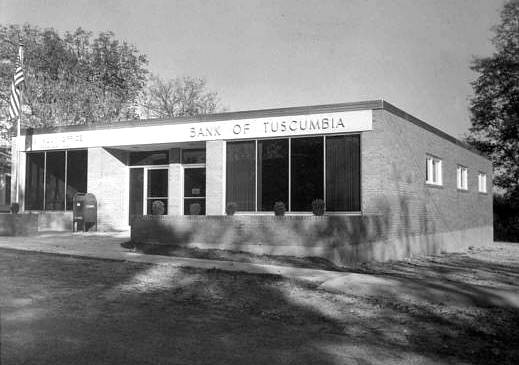
25 New Bank in 1960
The Tuscumbia Post Office also moved from the riverside to the new bank building renting space on the north end of the structure. An open house for the community was scheduled for October 9, 1960. The Miller County Autogram informed its readers of the upcoming open house with an article which gave some of the particulars about the new building and its staff and officers:
Miller County Autogram
Open House Will Be Held Sunday For New Tuscumbia Bank And Post Office
Clare Mace
October 6 1960
Open House from 2 to 4 p.m. Sunday October 9 for both the Bank of Tuscumbia and the Tuscumbia Post office at Tuscumbia’s new bank building has been announced. The present bank officers and personnel are H.C. Wright, president; B.H. Hix, cashier; and Mrs. Hannas Swanson and Mrs. Walter G. Abbott, bookkeepers. Other bank directors are D.E. Kallenbach and Dr. M. E. Humphreys.
G.A. Berry was assistant cashier from June 1944 until May 1959 and has assisted with bank work a great deal since his resignation.
Louie Apperson of Eldon was contractor in charge of construction of the 44 by 62 foot building which is built of haydite blocks with buff colored brick veneer. The tinted glass doors and window fronts provide a well lighted interior, but deflect heat and direct sunlight. A night depository is located near the front entrance of the bank.
Interior features include indirect lighting from ceiling panels, a concrete bank vault reinforced with steel, and Honduras mahogany paneling and woodwork in both post office and bank. The 3 ½ inch steel vault door weighs 5700 pounds. Inside the vault are 108 safety deposit boxes of various sizes.
The bank has a spacious customer lobby which is separated from the large work space by three tellers’ booths. There is a private booth for use of deposit box holders, a cloak room, storage room, furnace and air conditioning room, and rest room.
A folding partition may be used to form a private room at the back part of the main working area. New bank furnishings include two new walnut tables used as a directors’ table and a work table. Light green drapes harmonize with the interior color scheme. The floor is terrazzo covered. The north part of the building is leased by the Post Office Department and was designed to conform to government specifications. It has a box lobby, service lobby and a large work room. Screenline postal equipment, formica topped counters, and all other equipment necessary for the functioning of the post office are provided by the Post Office Department.
Not everything in the new bank, however, is new. The large fern that has been in the bank window since around 1910 has practically become an identifying feature of the bank. It is mounted on a tall pedestal and with its 7 to 8 foot long fronds, dominates the new front window, just as it did in the former building. Time is also marked by an antique clock on the wall, just as before.
The fern was said to have been brought to the bank around 1910 by Mrs. C.H. Clarke for safe keeping through the winter months, when she feared it might freeze at home. When it became so large it was unwieldy to move she decided to leave it at the bank permanently.
Cashiers of the bank since its opening in 1903 have been W.H. Hauenstein, W.A. Fendorf, C.E. Fendorf, L.A. Wright, Perry Wyrick, Orville Wyrick, and B.H. Hix, the present cashier.
One original stockholder, Miss Julia Jackson of Ulman, daughter of the bank’s first vice president, the late Honorable H.C. Jackson, still holds stock in the bank.
Julia Jackson of Ulman, the last named in the above article, was an early and faithful client of the Bank of Tuscumbia. Here is a photo of Julia taken from the article in the Autogram cited above (photo 26).
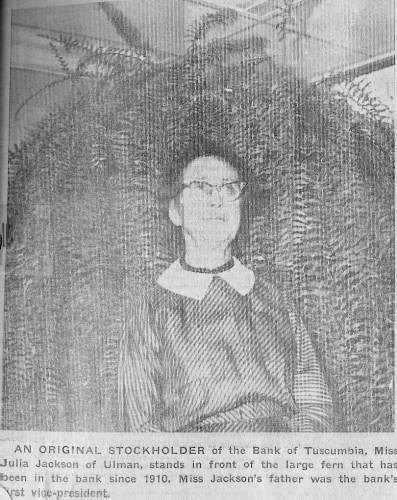
26 Julia Jackson
Click image for larger view
Julia’s father, Henry Clay Jackson, was the first vice president of the bank (photo 27).
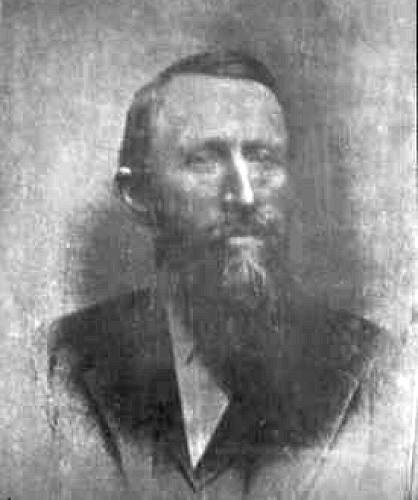
27 Henry Clay Jackson
Below are three more photos from the original article above of the officers and employees of the bank mentioned in the article (photos 28, 29 and 30).
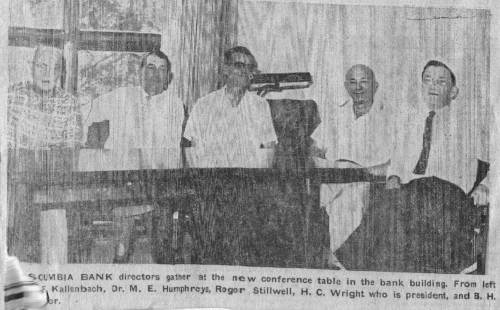
28 Dewey Kallenbach, Dr. M. E. Humphreys, Roger Stillwell, Homer Clay Wright and Byron Hix
Click image for larger view

29 Glen Warren, Assistant Cashier
Click image for larger view
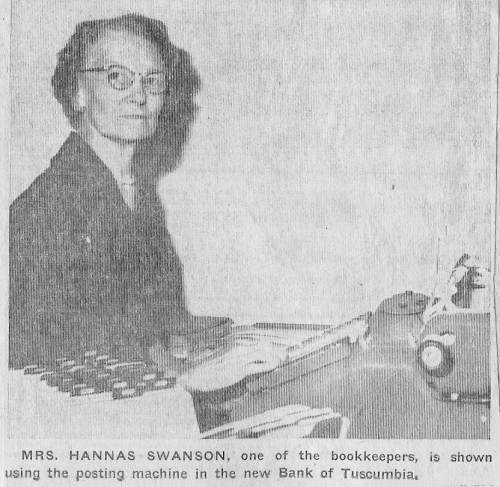
30 Mrs. Hannas Swanson
Click image for larger view
I was still in high school when the bank under the hill moved to the new building on top of the hill. I asked assistant cashier Glen Warren how he planned on getting all that money from the bank safe up to the new bank. He smiled and told me that when he opened up his office in the new bank he would write out a check and deposit it! I pondered that for some time. It’s good that I have a wife who knows how to balance a check book and keep track of things like that!
Here is a document of the guest book’s original pages where those who attended the open house on October 9, 1960 signed their names (photo 31):
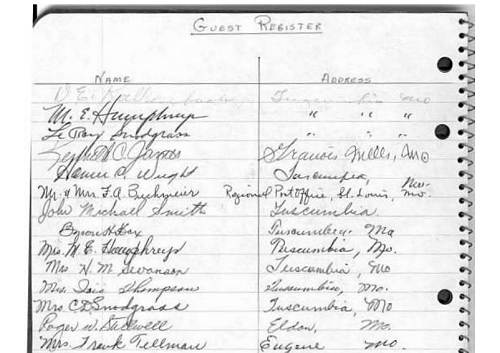
31 Open House Attendees
Click image to view entire document in PDF format
In the mid 1960’s Ralph Reimensnider, executive vice president, Frank Martin, assistant cashier, and Glen Warren were important figures in the management of the bank (photo 36).
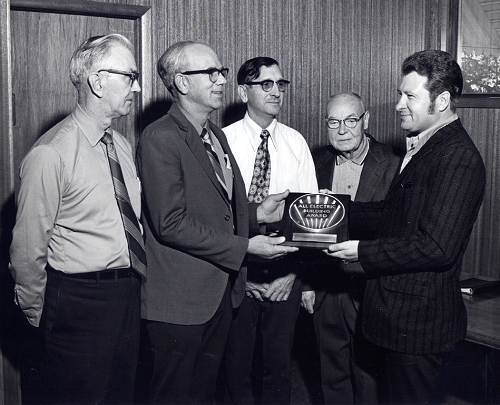
36 Bank of Tuscumbia: Glen Warren, Ralph Riemensnider, Frank Martin and Dewey Kallenbach
When Frank Martin retired in 1975, his position was replaced by Carl Kemna of St. Elizabeth (photo 37).
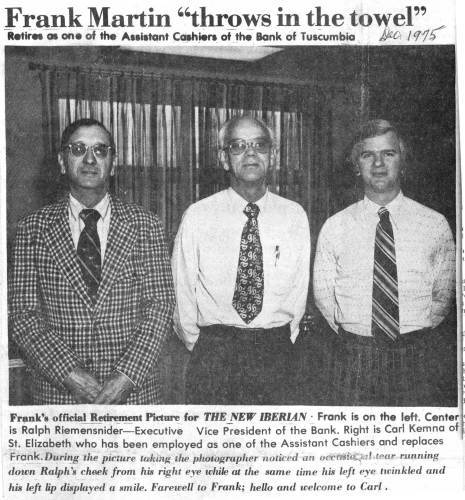
37 Frank Martin Retirement
Click image for larger view
In 1972 the post office moved to a different location not far away to occupy the building formerly known as the Kallenbach Appliance Store (photo 38).
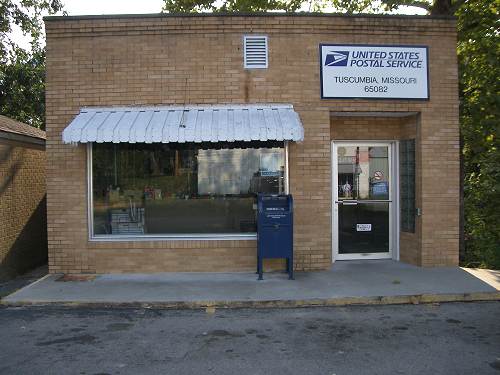
38 Current Post Office
Later, the bank expanded with a new façade and drive up facilities (photo 39).
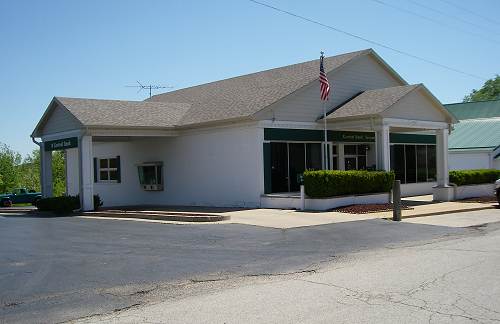
39 Current Bank of Tuscumbia
Carl Kemna now is Community Bank President of the bank now known as the Central Bank of Tuscumbia, a unit of the Central Bank of Jefferson City. Carl is quite personable and over these many years has made many friends who are now clients of the bank. He frequently participates in out reach activities of the bank in the Tuscumbia community such as this one at a bicycle marathon a couple of years ago (photo 40).
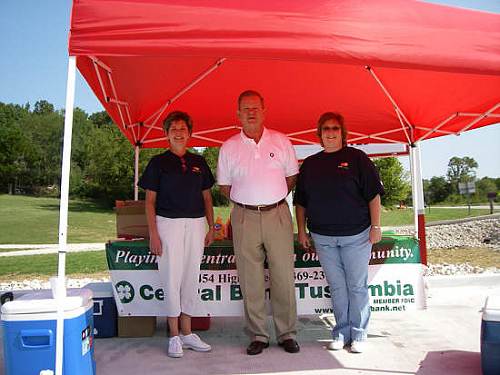
40 Kathy Snodgrass, Carl Kemna and Denise Wilson
The staff and Carl hold several informal community events yearly such as the outdoor luncheon at the front door just a couple of weeks ago (photo 41).
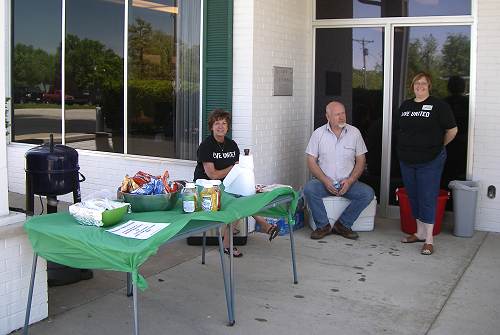
41 Bank Staff Kathy Snodgrass and Denise Wilson with Bank Guest Bo Alieksaites
The Autogram article cited above from which the history of the Bank of Tuscumbia was copied also gave a short history of the Tuscumbia Post Office:
Miller County Autogram
October, 1961
The history of the post office is more varied and the thread of facts concerning it is more difficult to trace. Serving as postmasters during the past 50 years or more have been George Sullivan, George P. Swanson (photo 42), J.N. Brockman (photo 43), James Spearman, C.O. Brockman (photo 44) and the present postmaster, Irvin Snodgrass (photos 45 and 45a).
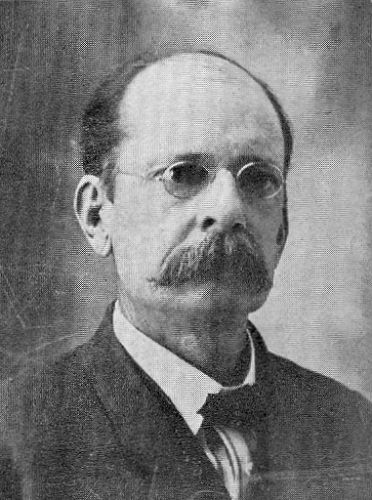
42 George P. Swanson
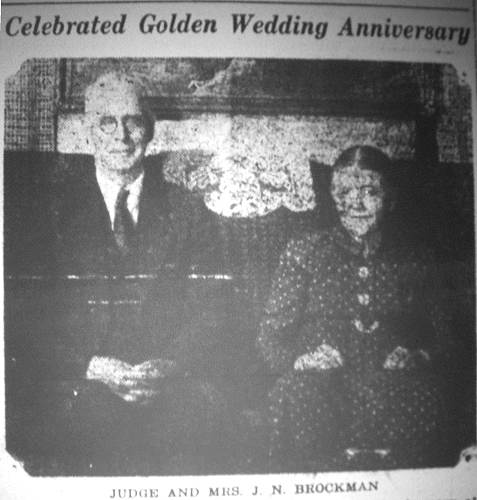
43 Judge and Mrs. John N. Brockman
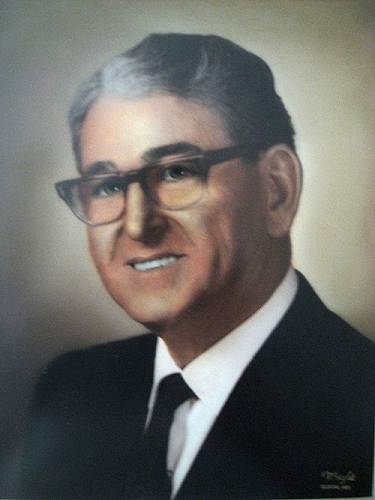
44 Oliver Brockman
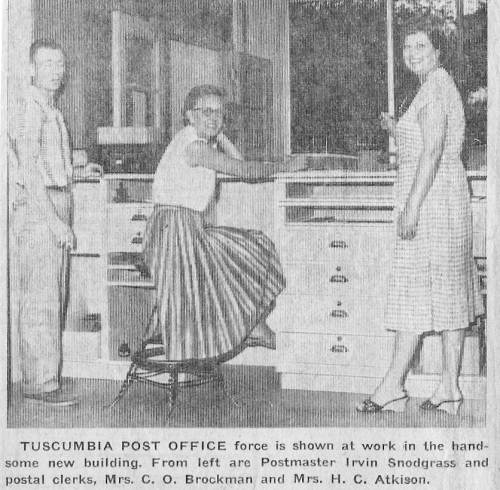
45 Tuscumbia Post Office Staff Irvin Snodgrass
Click image for larger view
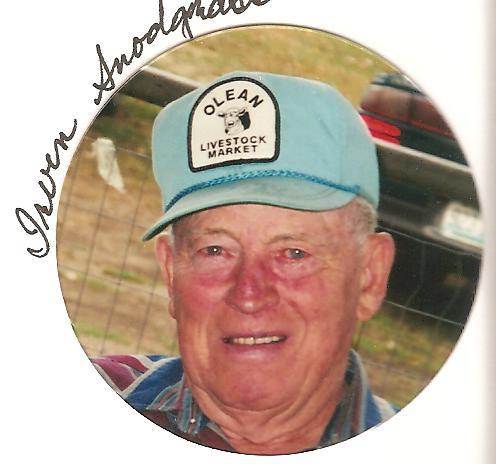
45a Irvin Snodgrass Note: after Irvin Snodgrass postmasters have been:
Jim Clark 1979-2001 (photo 46)
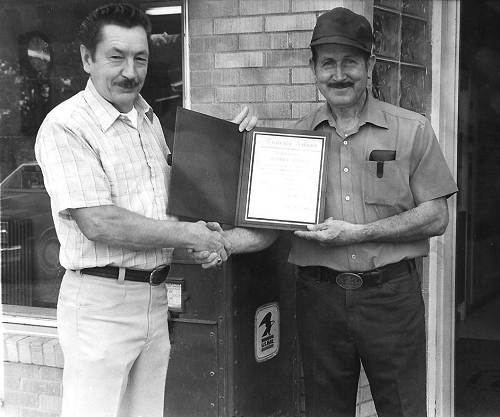
46 Jim Clark and Wilford Robinson
Lyman Burris 2001~2007
Debbie Cotten Woods - present postmaster (photo 46a)
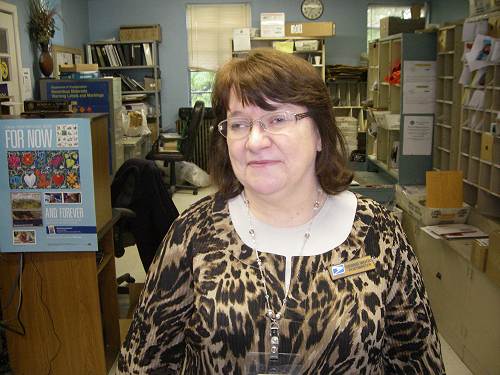
46a Debbie Cotten Woods, Tuscumbia Postmaster
The post office was moved into the new bank building on the hill in 1960 from a building then owned by Mr. and Mrs. J.Z. Spearman on the picturesque bluff site in downtown Tuscumbia (photo 47).
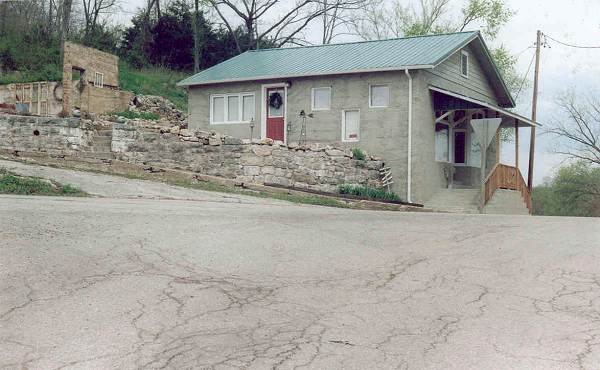
47 Current Photo of Old Post Office under the Hill
As noted above, in 1972 the post office was moved from the new bank building on the hill to the old Dewey Kallenbach Appliance store where it remains today (see photo 38 above).
Other locations of the post office before being moved to the James Spearman building under the hill near the river included a building that was washed away in the flood of May, 1943; one side of the present Tandy Jenkins building (Note: This was the old Woodman Fellow Hall building destroyed by fire several years ago), and a building that was previously located across the street from the Spearman building, then known as the Cummings building.
Tuscumbia’s post office was changed from third class to second class, July 1, 1950. The change was primarily due to increased receipts due to the mailing of cedar novelties made here.
Note: I remember when the post office was upgraded to second class. My father and his two brothers started the Pryor Novelty Company in 1937 in Tuscumbia. Cedar wood souvenirs were made there by local craftsmen and sold to outlets across the nation. The cedar wood products were shipped by truck, railroad and the post office. As the business grew it began daily shipments through the Post Office of a truck load of large cartons of cedar souvenirs. The increase in volume of shipments of these heavy containers filled with wooden products required a change in class for the Tuscumbia Post Office. You can read more about the Pryor Novelty Company at this previous Progress Notes.
Richard Wright was the first rural route mail carrier, beginning when the route was established May1, 1909, and served in that capacity for 45 years, retiring July 31, 1954 (photo 48).
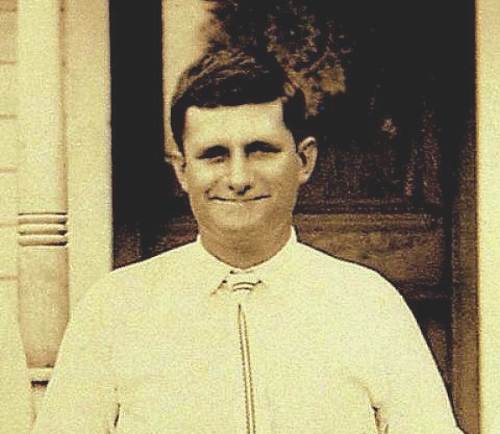
48 Richard Wright
The present carrier, Everett Cotten, was the next appointed carrier.
Note: The above article was written in 1960. Everett Cotten retired in 1979 (photo 48a).
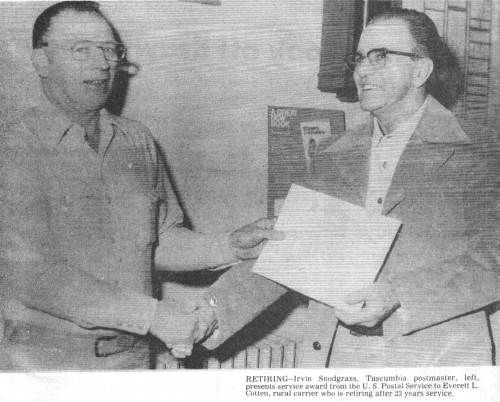
48a Everett Cotten Retirement - 1979
Click image for larger view
The present carrier now is Frank Schlesinger (photo 49).
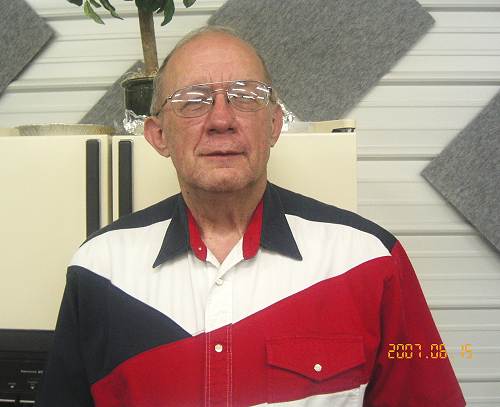
49 Frank Schlesinger
One of the interesting features of the present post office is that the bank of post office boxes in the lobby reserved for customers is the same one that was placed in the new post office building used after the first one flooded away in 1943. Here is a photo of those now antique but very functional boxes (photo 49a):
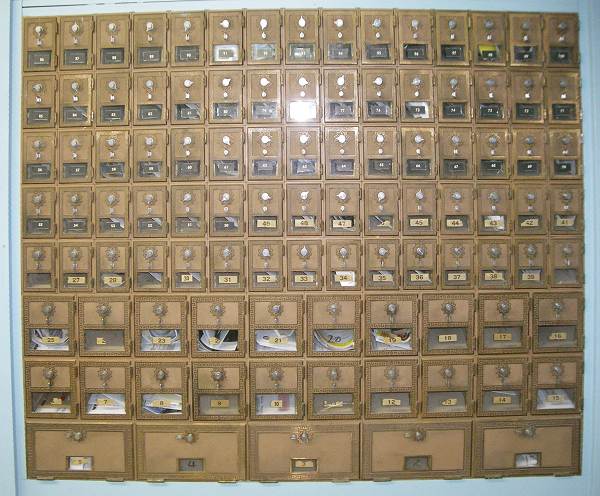
49a Original Post Office Boxes
Continuing the theme I enjoy of researching the lives of Miller County natives who leave here at an early age to pursue careers elsewhere, this week I will discuss the life of Iberia native John William Livingston (photo 50).
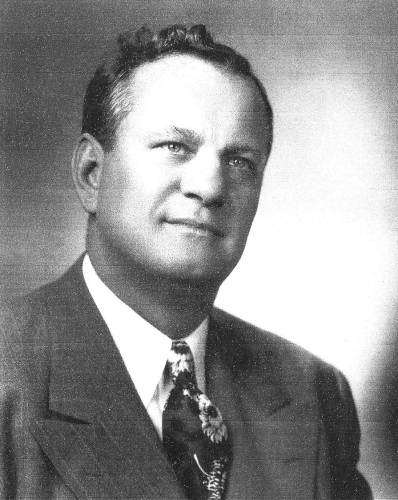
50 John William "Bill" Livingston
John was born and raised on a farm south of the Osage River near the Big Tavern Creek. He was the grandson of the Miller County Livingston patriarch, William Noe Livingston, and the son of Richard (Dick) and Mary Alice “Allee” Burks Livingston (photos 51 and 52).
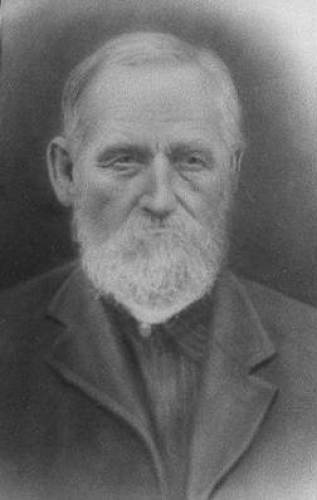
51 William Noe Livingston
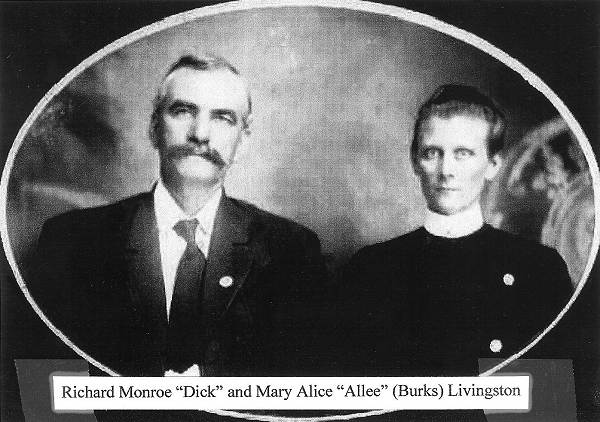
52 Richard and Mary Alice Allee Burks Livingston
The first two children of Dick and Allee were born in a log cabin (photo 53).
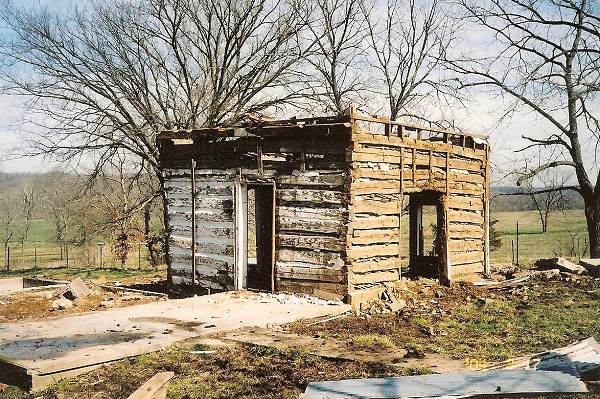
53 Remains of Log Cabin where first two childen were Born
A few years later they moved to a larger newer home where they had six more children including John (photo 54).
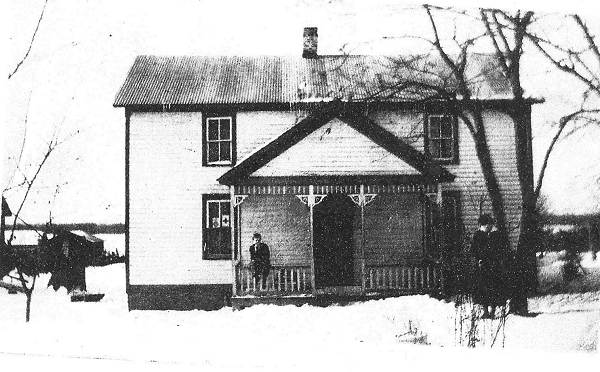
54 Home where John and five siblings were born
John did well in school being graduated from the Iberia Academy. His lifetime career began soon after he moved north to Detroit to become a laborer in the automobile industry. John advanced rapidly as a leader of his fellow employees to become a key figure in the early development of the organization of labor unions in this country.
John William Livingston, 1908-1997
A Biographical Sketch
By Rudolph Lewis
John W. Livingston, born August 17, 1908, on a farm in Iberia, Missouri (the foothills of the Ozarks), served the AFL-CIO in the post of Director of Organization for ten years, from the merger of the AFL and CIO in December 1955 to December 1965. During this period, Livingston demonstrated his well‑known skills as an administrator, negotiator, and organizer.
By the time Livingston was twenty-six, he was well into a lifelong career as a trade unionist. In December 1927, after attending Iberia Academy for two years, Livingston worked five years at the Fisher Body Division of the General Motors Corporation in St Louis, Missouri, where he worked in the trim department.
In 1930, he had a brush with management when he and some thirty other workers demanded an increase in their 40-cents-per-hour wage. For their boldness, Livingston and thirty-one other workers were summarily fired. A skillful worker, Livingston was soon back at Fisher.
The day the NRA was passed, June 1933, Livingston began his union activity. Eighteen workers met to plan how to organize workers in the Fisher plant. This meeting laid the groundwork for the establishment of Local No. 18386, which later became Local 25 of the UAW-CIO. Between 1934-1939, Livingston was elected and reelected president of this local union of auto workers.
In 1939, UAW-CIO employed Livingston as an International Representative in the General Motors Department. During his three years in this position, Livingston served as Vice‑Chairman and Chairman of the National UAW-GM Negotiating Committee.
In 1942, the UAW-CIO Convention elected Livingston Director of UAW Region 5 (Missouri, Kansas, Texas, Colorado, Louisiana, Oklahoma, Arkansas, and New Mexico) and a member of the International Executive Board. During the first eighteen months of his directorship, the UAW‑CIO membership in this region was increased thirteen‑fold.
Livingston continued to move up the organizational ladder of responsibility. In 1946, he was made co‑director, with UAW President Walter P. Reuther, of the union's General Motors Department. In 1952, Livingston assumed sole responsibility for this post. At the Atlantic City Convention in 1947, Livingston was first elected as one of the two international union vice‑presidents. He was reelected in 1949, 1951, 1953, and 1955.
In 1947, Livingston was also appointed director of the aircraft, airline, McQuay-Norris, and piston ring departments. Late in 1948 he became director of the agricultural implement department of the UAW-CIO. In 1952, he resigned from the directorship of this department, but kept the directorship of the national aircraft department.
Even with his many departmental duties, Livingston still participated in several organizing campaigns. He provided some leadership in the 1948 campaign to bring all farm implement workers in the UAW‑CIO ranks. He also coordinated the UAW‑Political Action committee campaign drive for the 1948 national Presidential election.
Before he became AFL-CIO's first Director of Organization, Livingston participated in virtually all UAW contract negotiations with the General Motors Corporation. In 1948, he was the chief international officer assigned to the General Motors wage and contract negotiations, in which the annual wage improvement and cost‑of‑living escalation was introduced.
In 1950, Livingston took part in the talks between the UAW and General Motors Corporation, which resulted in an unprecedented five‑year agreement later used as the model for agreements in many other industries. As leader of the UAW's bargaining team in the 1955 General Motors negotiations, Livingston established for the first time a full union shop and the principle of guaranteeing wages to laid‑off industrial workers.
Before 1955, Livingston had played important roles in both national and international assignments in which he helped to establish policies favorable to labor. During the summer of 1950, Livingston was chairman of a twelve‑man UAW-CIO delegation that visited England, France, Italy, and West Germany. In Paris, he presided over the first conference of the automotive and truck department of the international Metalworkers Federation. After conferring with European trade union official and with representatives of the Economic Cooperation Administration (ECA), Livingston presented a program, later adopted in a large measure, for implementing the Marshall Plan so that it would benefit people from all walks of life.
In May 1951 Livingston served for a year on the National Wage Stabilization Board in Washington. He played an important role in establishing policies free from the limitations of the War Labor Board, its World War II counterpart.
At the December 1965 convention of the AFL-CIO in San Francisco, Livingston retired at the youthful age of 57. From then until October 2, 1967, Livingston operated his cattle farm in the Ozarks. From then until 1968, he worked on the assembly line at the Fisher body plant in St. Louis and farmed on weekends.
In March 1968, President George Meany appointed Livingston as director of union relations of the National Alliance of Businessmen (NAB). To demonstrate the importance of the assignment the AFL‑CIO contributed Livingston's services with the NAB, established at the suggestion of President Johnson to undertake a program to employ the hard‑core unemployed.
John William Livingston married Rubye Britt on May 9, 1931. He is known to his friends as Jack. In his leisure hours he enjoys hunting and fishing. Business Week (November 19, 1955) noted that he had "a jovial, likeable personality; he is scrupulously honest and fair. His staff members swear by him."
At 88 years old, on May 25 in Westphalia, Missouri, Livingston died of unreported causes.
Here is a photo of John with Walter Reuther which was given me by a Livingston cousin, Carolyn Levell (photo 57b):
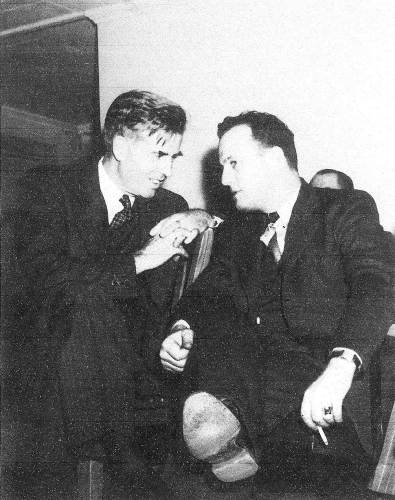
57b Walter Reuther and John Livingston
Before his retirement John bought a farm about five miles west of Tuscumbia on HH/Brockman Springs road, locally known as the River Road. The farm was known historically as the Billie Hauenstein farm. After retirement for a short time John and his wife lived in Tuscumbia at the Ida Hauenstein home, but later moved to Jefferson City.
John’s sister, Clarice Livingston Berry, was the wife of Iberia native Garrett Berry. They lived in Tuscumbia most of their later lives after Garrett was elected to public office at the courthouse. Here is a photo of Clarice taken at a Livingston family reunion some thirty years ago (photo 57e):
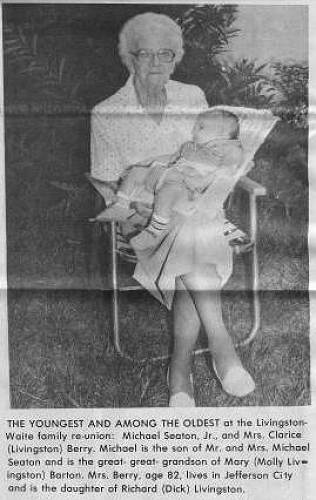
57e Clarice Livingston Berry
Judson Berry, son of Clarice and Garrett Berry, lived in Jefferson City when John and his wife lived there. I have been told that Judson was very attentive to John and his wife during their last years in Jefferson City.
The notice of John’s death was widely disseminated throughout the country and reported by major news outlets. Copied below is the obituary printed by the New York Times newspaper:
John W. Livingston, 88, Official Of Auto Union and A.F.L.-C.I.O.
By STEVEN GREENHOUSE
Published: May 31, 1997
John W. Livingston, the first organizing director of the A.F.L-C.I.O. and a longtime senior official in the United Automobile Workers, died on May 25 in Westphalia, Mo. He was 88.
Mr. Livingston, who was commonly called Jack, began organizing auto workers in 1933 when the U.A.W. was in its infancy and long served as a top lieutenant of Walter Reuther, who headed the union from 1946 until 1970.
In 1933, he helped establish what was to become a powerful U.A.W. local at a Fisher Body plant in St. Louis. He served as president of Local 25 until 1939, when he became a member of the union's General Motors department, which handled negotiations and relations between the union and the nation's largest auto maker.
In 1942, he was elected an executive board member, but he also served as a regional director based in Kansas City. In 1947, he was elected a vice president of the international union and moved to Detroit to oversee its important G.M. department. He also oversaw the union's activities in the aircraft and farm machinery industries. In 1951 and 1952, he served on the National Wage Stabilization Board, having been appointed by President Harry S. Truman.
Nelson Lichtenstein, a biographer of Mr. Reuther, said the U.A.W. president admired Mr. Livingston for his toughness, and thus chose him to head the G.M. department. But tensions developed between the two men when Mr. Livingston made clear that he did not endorse all of Mr. Reuther's ambitious agenda, include establishing a guaranteed annual wage for G.M. workers in the 1955 contract negotiations. In December 1955, Mr. Reuther eased Mr. Livingston out of the G.M. post.
Mr. Livingston then became the first organizing director of the organization created by the merger of the American Federation of Labor and the Congress of Industrial Organizations in 1955. It was a relatively tranquil time when the labor federation did not show the same fire in organizing that many unions did in the 1930's and immediately after World War II.
Mr. Livingston, was born on Aug. 17, 1908, near Iberia, Mo., the son of Richard M. and Mary Alice Burks Livingston. On May 9, 1931, he was married in St. Louis to Rubye Britt.
He remained A.F.L.-C.I.O. organizing director until 1965, when he retired to raise cattle near Tuscumbia, Mo.
He is survived by his wife.
I noticed that the obituary and the history of John Livingston printed above indicate that his friends called him “Jack.” However, his cousin, Catherine Burks Ponder, who is a volunteer at our museum, tells me that around home here in Miller County he was called “Bill.”
His local obituary printed in the Jefferson City Tribune offers more biographical information:
Obituary: Jefferson City Post Tribune, Tuesday, May 27, 1997
John W. Livingston, 88, Jefferson City, died Sunday at Westphalia Retirement Center. He was born Aug. 17, 1908, near Iberia, a son of Richard M. and Mary Alice Burks Livingston. He was married May 9, 1931, in St. Louis to Ruby Britt, who survives at the home.
A resident of Jefferson City since 1982, he was involved in the U.S. labor union movement. In 1933 he was instrumental in establishing a union at Fisher Body Plant, St. Louis, which became United Automobile Workers (UAW) Local 25. He was elected UAW executive board member and regional director in 1942, with offices in Kansas City.
In 1947, when he was elected UAW vice-president, he moved to Detroit to direct the union's operations in general Motors and in the aircraft and farm implement industries. He held that position until 1955. He served on the national Wage Stabilization Board in 1951 and 1952.
After the merger of the AFL and CIO, he was named director of organization of the AFL-CIO in Washington, D.C., a position he held until his retirement in 1965. After he retired, he operated a cattle farm near Tuscumbia.
A resident of Ft. Myers, Fla., from 1972 to 1982, he was a member of the Scottish Rite in Ft. Myers. He was a member of Capital City Christian Church, Raytown Lodge 391, A.F. & A.M., and the Moslem Temple, Detroit.
Services will be at 2 p.m. Wednesday at Houser-Millard Funeral Home. The Rev. Gary Baker will officiate. Burial will be in Livingston Cemetery, near Iberia. Visitation will be from noon-2 p.m. Wednesday. Memorials are suggested to Capital City Christian Church.
John Livingston’s story is both interesting as well as unexpected when one considers that while he was raised on a farm in the rural Ozarks of Missouri, he found his way to Detroit for one reason or another and became one of the most important figures in the union organization movement of our country during the first half of the last century.
Other members of the Miller County Livingston family were featured previously in the Progress Notes of October 18, 2010.
In that narrative I highlighted the careers of Ellis and Ross Livingston who were “half first cousins” having in common their grandfather, William Noe Livingston, but different grandmothers since William Noe Livingston had two wives. Both Ellis and Ross had distinguished records in their time in service as well as impressive academic careers.
Another Iberia Livingston I featured previously was Fred Livingston who was a hero of WWII. You can read his remarkable story at this previous Progress Notes.
I received the following comments from former Miller County native Lois Mace Webb (photo 58) recently regarding several of the stories of the Progress Notes of April 18:
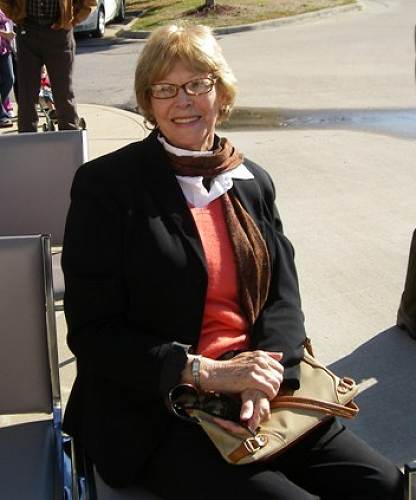
58 Lois Mace Webb
Joe,
My mind responded immediately after reading your Progress Notes of April 18, 2011.
It was a remarkable tribute to Ted Stamper and his family. So glad you did that. If there is such a thing as regression therapy, interaction with your Progress Notes serves such for me. So many events mentioned in your articles trigger recall of happenings long since asleep in my brain. The pictures of Ted and Bethel, and Wilford Robinson, for instance, were good to refresh their image. And evidently you visited with Luane, Ted’s daughter. I'd forgotten about Ted's Cedar Novelty business, the house burning, and oh so many things, including his work in Washington.
Recently at Linda Hall Library here in Kansas City, a series of lectures on “Coming into the Atomic Age, The Hanford Project” was discussed; I doubt any of us in Brumley (or other places for that matter) had any idea what was going on there. If anyone, it would have been Bob (Omer) Robinet. But that work was all quite secretive, even to Harry Truman I suppose. It was interesting to know that our own Ted Stamper worked there and the fact that he was selected validates his expertise.
And the Aunt Cynthia Spearman story caused me to remember that indeed I attended her Birthday Event. It was a big deal in Brumley. Your story was the first I ever heard details of exactly how she lost her arms in the cane press accident; and the amputation process by Dr. Nixdorf also was new information to me. It was said she could "give a good switching" to the big boys in her classes. And indeed I've seen her use her arms effectively and with efficiency -- a marvel to this child's eyes. And I hadn't remembered that she was a School County official. So good to recall those long buried events.
Also, Mildred Messersmith Gray's account of Tuscumbia basketball players was fun to read. As she said, all basketball courts were outdoors then, and those half court shots were not uncommon. I recall Brumley's outdoor court and that my uncle Harrison Mace was similar to Mildred's description of those ‘ole’ country boys being tough as nails and ready to play ball. I can remember seeing Harrison shoot and sink a basket about like Mildred described. Harrison's story was this:
“Brumley didn't have many players, so when they played better equipped teams, Brumley's strategy was to put in their weakest players to begin the game, have them foul out the opponents best players as soon as possible, thus leaving Brumley's better players to finish the game with the opponent's weaker players.”
And it worked most of the time because Brumley boasted consistent winnings. Basketball must have been Miller County's prime sport. I loved Mildred's account.
Jumping now to Mrs. Steen and her quilts for your grand girls -- was a joy to see that account. Your three grandgirls remind me of the story of the Fogelman girls -- Helen, Ruby, Pauline, and Lillian. The Fogelman story is one worth fleshing out sometime too. Mr. Fogelman's (Will Fogleman) saying was that he drew a good hand -- four queens (photo 59).
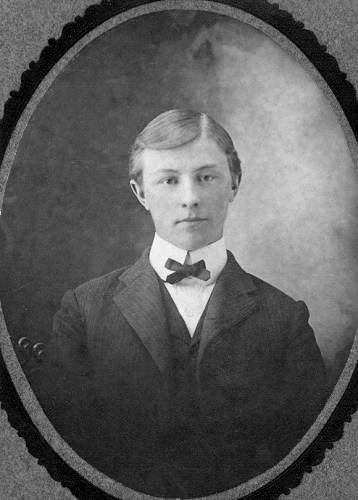
59 Will Fogleman when a Young Man
Lillian lives in the Raytown area; I phone-visit with her on occasion and through her keep moderately in touch with Ruby, living in a retirement complex (Kingswood) at about l00th and Wornall, and Pauline in Washington DC.
Mr. Fogelman maintained a road construction business; he wouldn't let a workman fell a tree because of danger; instead Mr. Fogleman did the job. One day a tree fell on Mr. Fogleman and killed him.
I recall that she worked as the alterations lady at Ridgeway's clothing store in Eldon for a long time. Your mother will remember Ridgeways, a store featuring nice clothing for women. I've been around the Fogelman family so much I recall many anecdotes. One was about Helen (later the wife Tolliver Lawson), the oldest of the four girls, and the road crew of workmen who stayed in something like a bunkhouse on the Fogelman place. The workmen excitedly cut and decorated a Christmas tree for Helen's Christmas and were on hand early to watch as she came to the room to see it. Sure enough, she came in dressed in her little white nightie, rubbed her eyes and looked at the tree and said: “Well, son-a-bitch, a trissy tree.” Immediately, Mr. Fogelman enforced new rules about language of the workmen in presence of family.
It is my understanding that Ruby and Pauline went to Washington DC, evidently along with many young females in interest of WWII effort (men all going to service) to work in offices and the like. Helen was married to Tolliver Lawson, and Lillian was preparing to marry Victor Thomas. Ruby's husband was a university professor in Louisiana where they lived and raised their family until she moved to the KC area, near a son, a decade ago. Pauline and her husband lived and raised a family in DC, where Pauline still maintains her home. I joined them a few years ago in meeting with Janet Hix for a showing of Janet's artwork. We bought several; Pauline, as I recall, bought quite a few and has told of a special place for hanging one painting in particular.
This subject is far afield from your recent Progress Notes, but your three Grand Girls reminded me of Mr. Fogelman's Four Queens. And they also remind me that the Fogelman family could supply good Miller County stories as well as their own history.
Thanks always, Joe, for your work on behalf of Miller County families. Always interesting. Again, so grateful for the Ted Stamper story -- truly a remarkable man, wasn't he?
Thanks Lois for your interesting comments.
The Will Fogleman tragic death was one of the most remembered tragedies of Tuscumbia history. One reason was that he was a very successful business man and road contractor. The other is that he was a direct descendent of the historical Hauenstein family; his mother Augusta Hauenstein Fogleman was a daughter of the original Hauenstein to come to Tuscumbia, William Hauenstein.
I went to the Vernon Publishing Company Archives to copy the news paper account of the story from the Eldon Advertiser:
The Eldon Advertiser
April 1, 1937
William F. Fogleman Fatally Injured By Falling Walnut Tree
Is Trapped When Root Unexpectedly Breaks
Was Helping Guide Tree Down With Rope When Accident Occurred Thursday
William F. Fogleman was fatally injured by a tree falling on him Thursday afternoon while at work on his farm, about five miles northeast of Tuscumbia on Highway 17, and died within a short time.
Mr. Fogleman was helping to direct the fall of a walnut tree by the use of a rope when the accident occurred. He and two other men had anchored the tree with the rope to another tree and had chopped off all the roots except the tap root. The men were trying to tighten the rope to make sure the tree would fall the direction they intended and called Mr. Fogleman to help them. When the three pulled on the rope the tap root broke off suddenly allowing the tree to fall toward the men. All three men fell and as they got up to run, Fogleman became entangled in the rope, being nearer the falling tree, and one of the two large limbs about twenty feet up from the root struck him across the neck and legs. Both legs were broken and his body was crushed.
Mr. Fogleman had been a successful highway contractor for several years and spent much of his time away from his farm. He had been awarded a highway contract for the construction of a farm to market road between Tuscumbia and Bagnell, and was to have started work there Monday. He was a man well liked by the men whom he employed and by many people of the county who knew him. His foreman was considered one of the best in the state on road work. It is probable that Mrs. Fogleman may continue the contract with the foreman in charge.
Coming from one of the older families of the county, Mr. Fogleman was born November 15, 1896, his parents being John W. and Augusta Hauenstein Fogleman. He was married in March of 1912 and is survived by Mrs. Fogleman and four children, Mrs. Toliver Lawson of Tuscumbia, Ruby, Pauline and Lillian Fogleman.
The funeral was held Saturday at the Tuscumbia Presbyterian Church by the pastor of the Presbyterian Church of Fulton, assisted by the pastor of the Presbyterian Church at Tuscumbia. Burial was made at the Dooley Cemetery near Rocky Mount.
John Fogleman, father of Will Fogleman about whose family Lois wrote above, was an important figure in early Miller County history (photo 60).
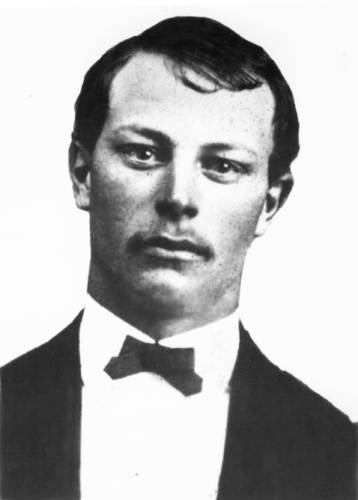
60 John Fogleman
You can read more about the historical Fogleman family at these websites:
Note: You will have to scroll down the page on the websites to find the Fogleman narratives.
Progress Notes of April 29, 2007
Progress Notes of November 19, 2007
Progress Notes of October 1, 2011
Miller County Biographies
Recently, our museum director Nancy Thompson attended a meeting at the Missouri State Archives in Jefferson City which honored the many Archives volunteers. The meeting was hosted by Secretary of State, Robin Carnahan. Here is a photo of Nancy and Secretary Carnahan the day of the meeting (photo 61):
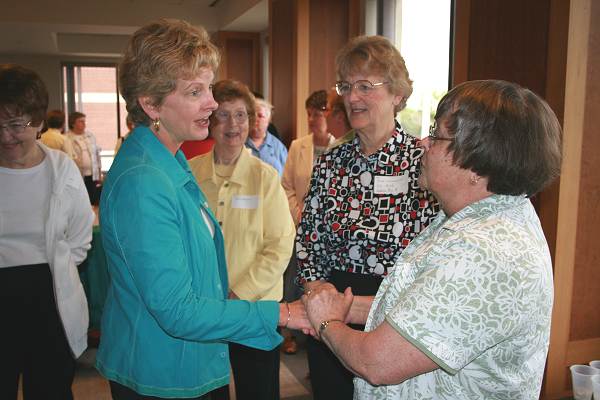
61 Secretary of State Robin Carnahan and Miller County Museum Director Nancy Thompson
Nancy has led an effort supported by the State Archives to microfilm all our probate files, some of which are more than one hundred years old and are rapidly deteriorating. Recently, after about two years, the museum staff and volunteers finished the process for preparing the files for microfilming.
Nancy’s day at the event was highlighted when she won the drawing for the best prize!
Here is a press release describing the event:
For immediate release: April 28, 2011
Contact: Laura Egerdal 573-526-0949
Carnahan Honors Volunteers at State Archives for Efforts to Preserve Missouri History
Jefferson City, MO – Secretary of State Robin Carnahan today honored the dedicated volunteers who serve at the Missouri State Archives. In Jefferson City, volunteers give tours and process historic documents, but volunteers can contribute from anywhere in the world through an online e-Volunteer program. This year, 275 e-volunteers processed more than 49,000 death records in less than 3 days, making the documents available on MissouriDigitalHeritage.com in record time.
“I am grateful for each of the volunteers in the State Archives,” Carnahan said, speaking to nearly 40 volunteers at her office in Jefferson City. “Thanks to your hard work, Missourians have unprecedented access to our state’s heritage through digital collections.”
The Missouri State Archives has several opportunities for new volunteers, including in-house records processing, records preservation in other locations across the state, online e-Volunteer projects and in-house docents. Volunteers are encouraged to choose an opportunity that suits their interests and skills. Current projects include processing the 1910-1960 World War II Missouri Soldiers’ Reports of Separation.
If you are interested in volunteering with the State Archives, please contact Christina Miller at archref@sos.mo.gov or (573) 751-3280.
The museum officially opened last Saturday, May 14 for the summer season. We served refreshments and beverages to a large number of visitors throughout the day. We were entertained the entire afternoon by Joe Jeffries and his bluegrass band (photo 62).
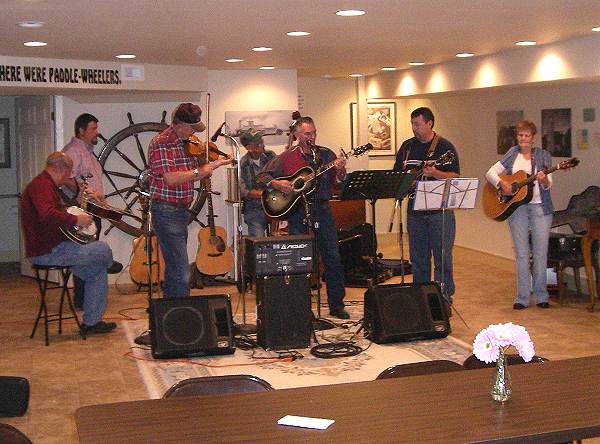
62 Joe Jeffries Group
In the photo left to right are Frank Simpson: banjo; Dan Tannehill: dobro; Clifford Hill: fiddle; Joe Jeffries: bass; David Cotten: guitar; Myran Cotten: mandolin; and Betty Simpson guitar.
Also entertaining were Tammy and Charles Wells who offered wonderful instrumental accompaniment to their beautiful vocal harmonizing (photo 63).
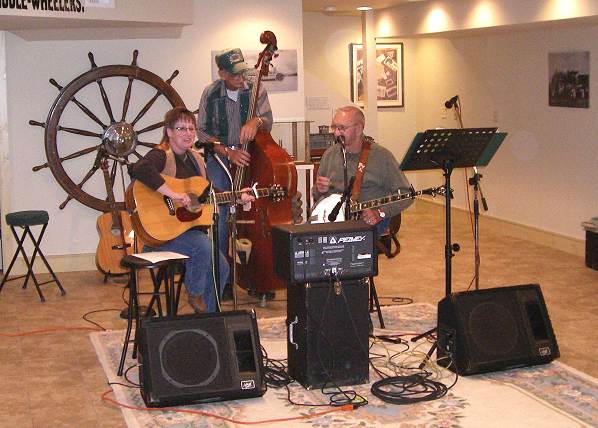
63 Tammy and Charles Wells
An audience filled the seating area during the entire musical show (photo 64).
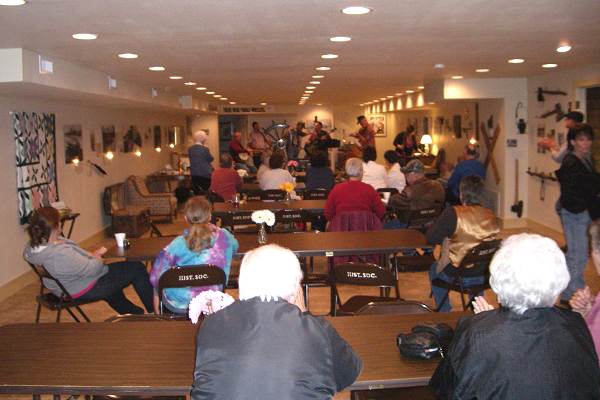
64 Audience for Joe Jeffries Band
David Cotten, who is the guitarist at the microphone in photo 62 above, recently donated to the museum a broadaxe used by his grandfather, John Pleasant Cotten, which was used for cutting railroad ties (photos 65 and 66).
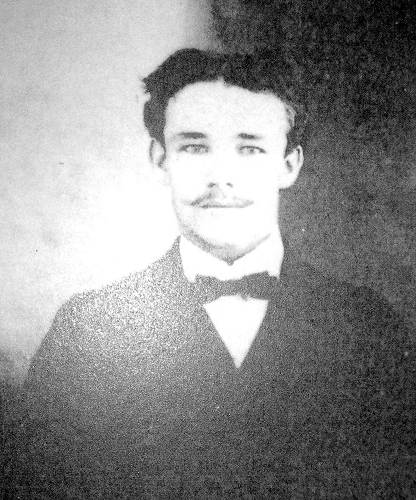
65 John Pleasant Cotten
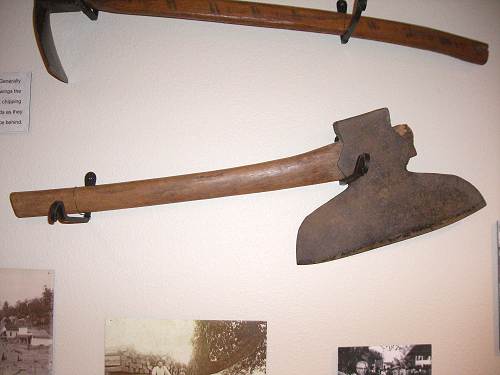
66 John Pleasant Cotten Broad Axe
David said that his grandfather lived on a farm between Bagnell Dam and Old Bagnell having moved there from a farm above the dam before the lake flooded that area. Here is another photo of John Cotten and his wife, Maggie, a number of years after their move (photo 67):
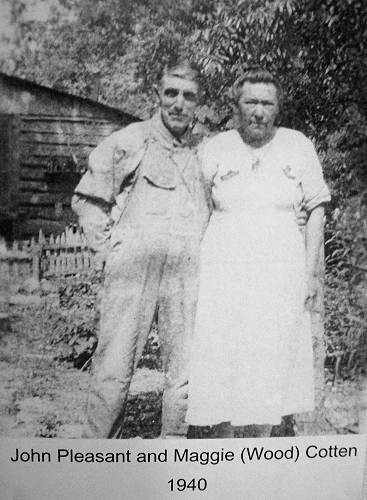
67 John Pleasant and Maggie Cotten
We are very appreciative of the donation of this historical item by David for our museum.
That’s all for this week.
 Joe Pryor
Previous article links are in a dropdown menu at the top of all of the pages.
|

